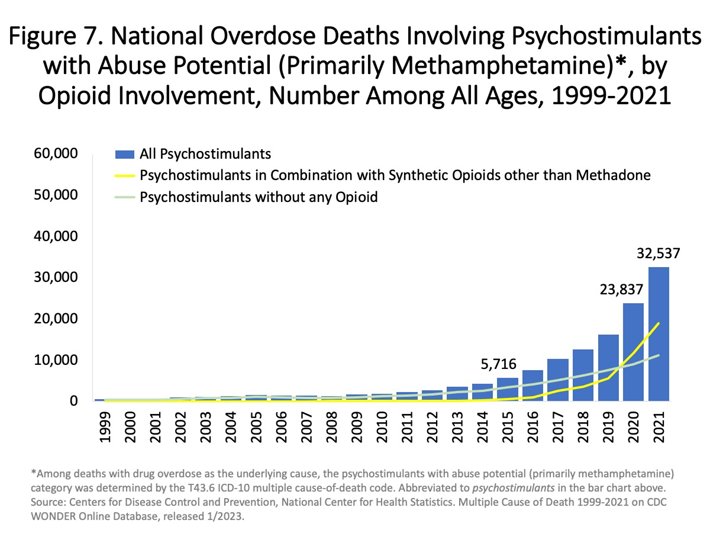Methamphetamine Deaths Increased by More Than 50-Fold Between 1999 and 2021—Fentanyl Largely to Blame

“I won’t overdose on that drug—it’s not an opioid.” For decades, people who have become addicted to mind-altering substances like methamphetamine and other non-opioid drugs have used this line to justify using their drug of choice.
It was never a valid defense, as ALL drug use is harmful and can lead to devastating consequences. But the excuse is especially null and void today, as recent reports show meth-related deaths have skyrocketed more than 50X due in part to fentanyl being mixed into meth.
NIDA Reports Indicate an Almost 60X Increase in Meth-Related Deaths
A National Institute on Drug Abuse (NIDA) report on total drug overdose deaths through the 21st century lays out a painful story of meth-related deaths. According to the data, there were 547 psychostimulant (primarily meth) deaths in 1999. In 2020, there were 23,837 such deaths. Just one year later, in 2021, there were 32,537 deaths.
How did one drug go from claiming 547 lives in 1999 to 32,537 lives just 22 years later? What accounts for the almost 60X increase in deaths?
According to recent reports, fentanyl and other opioids are being added to meth batches across the nation to make the meth high more potent. The only problem is that fentanyl is an extremely dangerous opioid that can easily cause a fatal overdose.
What the Findings Show
The NIDA report is backed by hard research that carefully analyzed toxicology reports for overdose victims nationwide between 1999 and 2021. The research was performed by professors of epidemiology at the University of Illinois at Urbana-Champaign.

While the trend of mixing street opioids with methamphetamine is not new, the potency of the drugs has increased in recent years, hence the spike from 23,837 meth-related deaths in 2020 to 32,537 such deaths in 2021. Dr. Rachel Hoopsick, professor of epidemiology and lead researcher in the University of Illinois at Urbana-Champaign report, spoke to this point. “Mixing methamphetamine and opioids isn’t a new phenomenon,” she said. “Although there has been an increase in the popularity of using these types of substances together, what has truly changed is the toxicity of the unregulated street drug supply, predominantly of fentanyl and other synthetic opioids. I believe that this is the primary driver of the increase in deaths.” According to research published by Dr. Hoopsick and her colleagues, at least 61% of fatal meth overdoses also involved fentanyl or heroin.

Further, when they published their research in the Journal of the American Public Health Association, Dr. Hoopsick and her colleagues cited meth-related deaths as far higher than the NIDA research estimated. According to their paper, at least 52,400 deaths in 2021 could be attributed to meth, a far greater figure than the 32,537 deaths identified by NIDA.
The researchers also noted that, while mixing drugs is not a new trend, evidence of fentanyl tainting supplies of meth did not become a nationwide issue until around 2010. Dr. Hoopsick says the answer is more treatment for those addicted. “There is a real lack of treatment options for folks with stimulant use disorder,” she said. “Very few folks with stimulant use disorder access treatment, compounded by barriers to care, stigma, and limited evidence-based treatment options for stimulant use disorder.”
“The fentanyl crisis must be curbed through better interdiction and more wide-scale public awareness of the dangers of taking any non-prescribed drug, as upwards of 60% of the confiscated illegal drug supply is contaminated with deadly doses of fentanyl.”
In addition to treatment, more must be done to curb the drug’s supply and reduce demand by providing educational programs to raise awareness of the harms of meth AND fentanyl. Linda Richter, vice president for prevention research and analysis at the Partnership to End Addiction, reviewed the findings and offered these suggestions to combat the crisis: “This country has a history of focusing virtually exclusively on one particular drug at a time, rather than on recognizing that all forms of substance use are driven by similar and overlapping factors, that most people who used drugs use more than one type, and that the interventions that work to prevent and treat one form of substance misuse or addiction are similar across all the misused substances,” she said. “The fentanyl crisis must be curbed through better interdiction and more wide-scale public awareness of the dangers of taking any non-prescribed drug, as upwards of 60% of the confiscated illegal drug supply is contaminated with deadly doses of fentanyl.” In addition to raising awareness and increasing interdiction efforts, it’s clear that more needs to be done to ensure people addicted to any drug have access to effective, quality treatment options.
Meth Overdoses. Know What to Look For, Save a Life.

Given that meth-related overdoses are far more common now than they ever used to be—and far more likely to be fatal—people should know how to spot them quickly. While such overdoses can be more difficult to recognize than opioid overdoses, there are warning signs to look for. Anger, aggression, restlessness, confusion, dark urine, dizziness, fainting, fast breathing, and irregular heartbeat can all be signs that one is either about to overdose on meth or is currently overdosing. Other signs include muscle cramps, pain, stiffness, seizures, sweating, tremor, unusual tiredness, weakness, stomach cramps, and vomiting.
The Need for Treatment
In today’s drug landscape, an addict truly never knows what lethal substance awaits them in their drug supply. That is why it is so critical for struggling addicts to get help as soon as possible. If you know someone using drugs, please assist them in entering a qualified residential drug treatment center. Please don’t wait until it is too late.
Sources Cited:
- NIDA. “Drug Overdose Death Rates.” National Institute on Drug Abuse, 2023. nida.nih.gov
- AJPH. “Methamphetamine-Related Mortality in the United States: Co-Involvement of Heroin and Fentanyl, 1999–2021.” The American Journal of Public Health, 2022. ajph.aphapublications.org
- USNews. “U.S. Deaths Involving Meth Are Skyrocketing, Fentanyl a Big Factor.” U.S. News, 2023. usnews.com


 ®
®